Marketing Scorecard for Future-Proofing Strategy in Abu Dhabi, UAE
VerifiedAdded on 2022/08/10
|12
|3758
|19
Project
AI Summary
This project proposal outlines a research study focused on developing a marketing scorecard for future-proofing strategies in the government sector organizations in Abu Dhabi, UAE. The research aims to identify key performance indicators (KPIs) for marketing and sales to drive organizational performance. The proposal includes an overview of the study's significance, aims and objectives, relevant literature review, and the chosen qualitative research design, which utilizes grounded theory and phenomenology. The methodology involves collecting primary and secondary data, with a focus on grounded theory for data analysis. The proposal also addresses ethical considerations, anticipated outcomes, and expected timelines, providing a comprehensive framework for the research. The study intends to investigate how KPIs influence organizational performance, how they can be effectively measured, and what strategies can be employed to ensure the marketing strategy remains relevant amidst evolving market conditions, technological advancements, and changing consumer preferences. The research emphasizes the importance of future-proofing strategies, including building brand associations, maintaining a flexible marketing hierarchy, embracing diversity, and offering customer experiences rather than just products.

Management
Paraphrase This Document
Need a fresh take? Get an instant paraphrase of this document with our AI Paraphraser
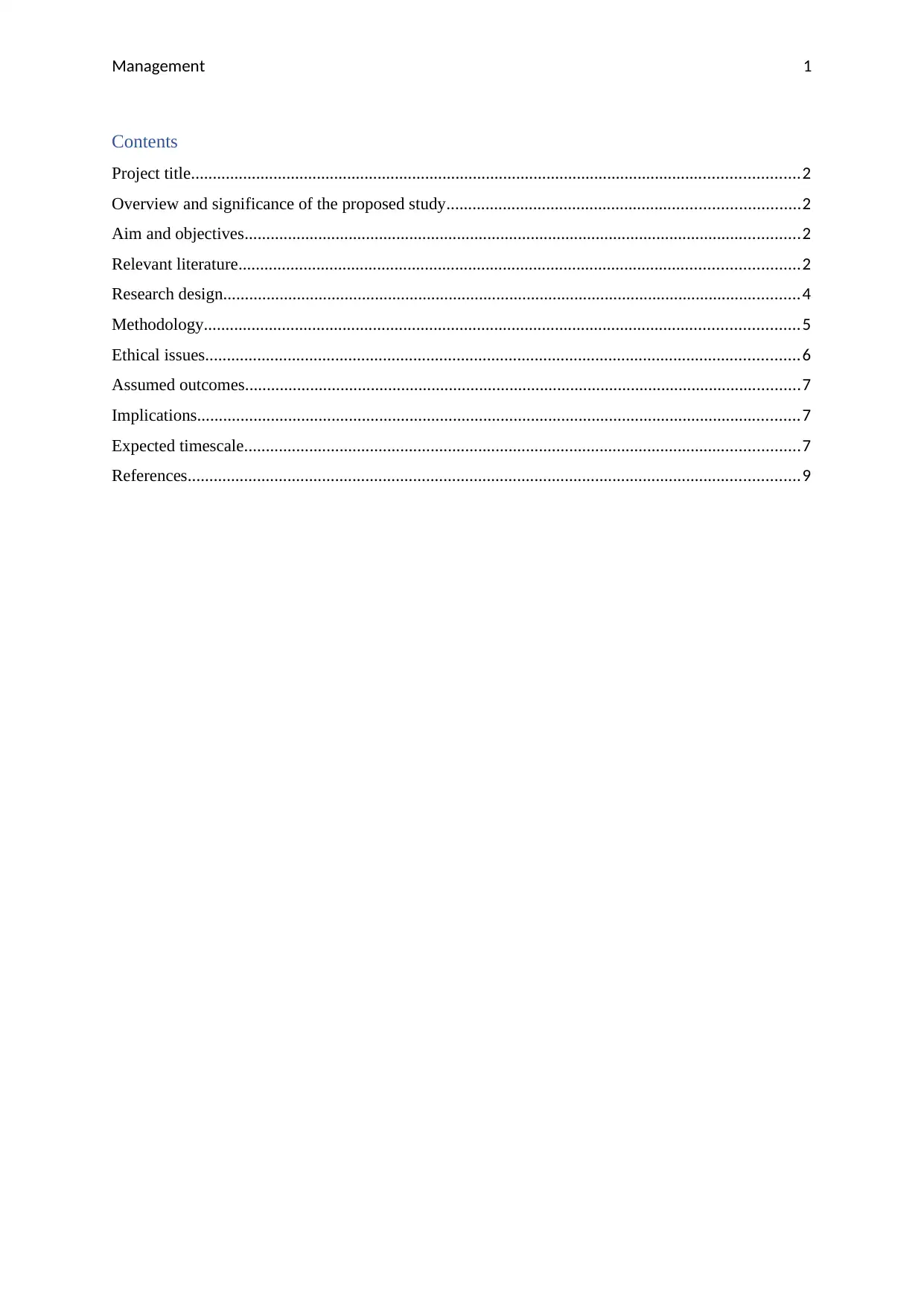
Management 1
Contents
Project title............................................................................................................................................2
Overview and significance of the proposed study.................................................................................2
Aim and objectives................................................................................................................................2
Relevant literature.................................................................................................................................2
Research design.....................................................................................................................................4
Methodology.........................................................................................................................................5
Ethical issues.........................................................................................................................................6
Assumed outcomes................................................................................................................................7
Implications...........................................................................................................................................7
Expected timescale................................................................................................................................7
References.............................................................................................................................................9
Contents
Project title............................................................................................................................................2
Overview and significance of the proposed study.................................................................................2
Aim and objectives................................................................................................................................2
Relevant literature.................................................................................................................................2
Research design.....................................................................................................................................4
Methodology.........................................................................................................................................5
Ethical issues.........................................................................................................................................6
Assumed outcomes................................................................................................................................7
Implications...........................................................................................................................................7
Expected timescale................................................................................................................................7
References.............................................................................................................................................9
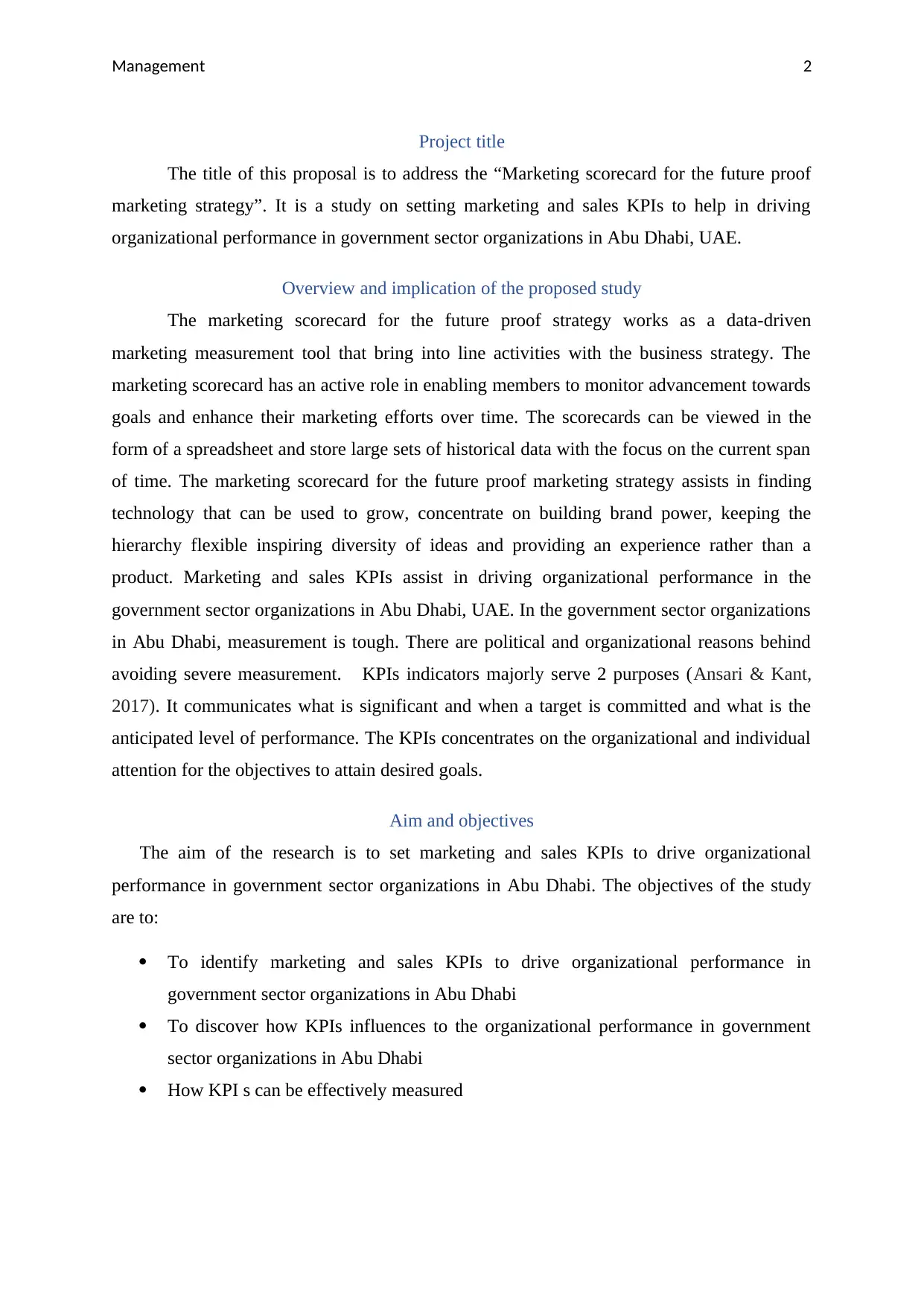
Management 2
Project title
The title of this proposal is to address the “Marketing scorecard for the future proof
marketing strategy”. It is a study on setting marketing and sales KPIs to help in driving
organizational performance in government sector organizations in Abu Dhabi, UAE.
Overview and implication of the proposed study
The marketing scorecard for the future proof strategy works as a data-driven
marketing measurement tool that bring into line activities with the business strategy. The
marketing scorecard has an active role in enabling members to monitor advancement towards
goals and enhance their marketing efforts over time. The scorecards can be viewed in the
form of a spreadsheet and store large sets of historical data with the focus on the current span
of time. The marketing scorecard for the future proof marketing strategy assists in finding
technology that can be used to grow, concentrate on building brand power, keeping the
hierarchy flexible inspiring diversity of ideas and providing an experience rather than a
product. Marketing and sales KPIs assist in driving organizational performance in the
government sector organizations in Abu Dhabi, UAE. In the government sector organizations
in Abu Dhabi, measurement is tough. There are political and organizational reasons behind
avoiding severe measurement. KPIs indicators majorly serve 2 purposes (Ansari & Kant,
2017). It communicates what is significant and when a target is committed and what is the
anticipated level of performance. The KPIs concentrates on the organizational and individual
attention for the objectives to attain desired goals.
Aim and objectives
The aim of the research is to set marketing and sales KPIs to drive organizational
performance in government sector organizations in Abu Dhabi. The objectives of the study
are to:
To identify marketing and sales KPIs to drive organizational performance in
government sector organizations in Abu Dhabi
To discover how KPIs influences to the organizational performance in government
sector organizations in Abu Dhabi
How KPI s can be effectively measured
Project title
The title of this proposal is to address the “Marketing scorecard for the future proof
marketing strategy”. It is a study on setting marketing and sales KPIs to help in driving
organizational performance in government sector organizations in Abu Dhabi, UAE.
Overview and implication of the proposed study
The marketing scorecard for the future proof strategy works as a data-driven
marketing measurement tool that bring into line activities with the business strategy. The
marketing scorecard has an active role in enabling members to monitor advancement towards
goals and enhance their marketing efforts over time. The scorecards can be viewed in the
form of a spreadsheet and store large sets of historical data with the focus on the current span
of time. The marketing scorecard for the future proof marketing strategy assists in finding
technology that can be used to grow, concentrate on building brand power, keeping the
hierarchy flexible inspiring diversity of ideas and providing an experience rather than a
product. Marketing and sales KPIs assist in driving organizational performance in the
government sector organizations in Abu Dhabi, UAE. In the government sector organizations
in Abu Dhabi, measurement is tough. There are political and organizational reasons behind
avoiding severe measurement. KPIs indicators majorly serve 2 purposes (Ansari & Kant,
2017). It communicates what is significant and when a target is committed and what is the
anticipated level of performance. The KPIs concentrates on the organizational and individual
attention for the objectives to attain desired goals.
Aim and objectives
The aim of the research is to set marketing and sales KPIs to drive organizational
performance in government sector organizations in Abu Dhabi. The objectives of the study
are to:
To identify marketing and sales KPIs to drive organizational performance in
government sector organizations in Abu Dhabi
To discover how KPIs influences to the organizational performance in government
sector organizations in Abu Dhabi
How KPI s can be effectively measured
⊘ This is a preview!⊘
Do you want full access?
Subscribe today to unlock all pages.

Trusted by 1+ million students worldwide
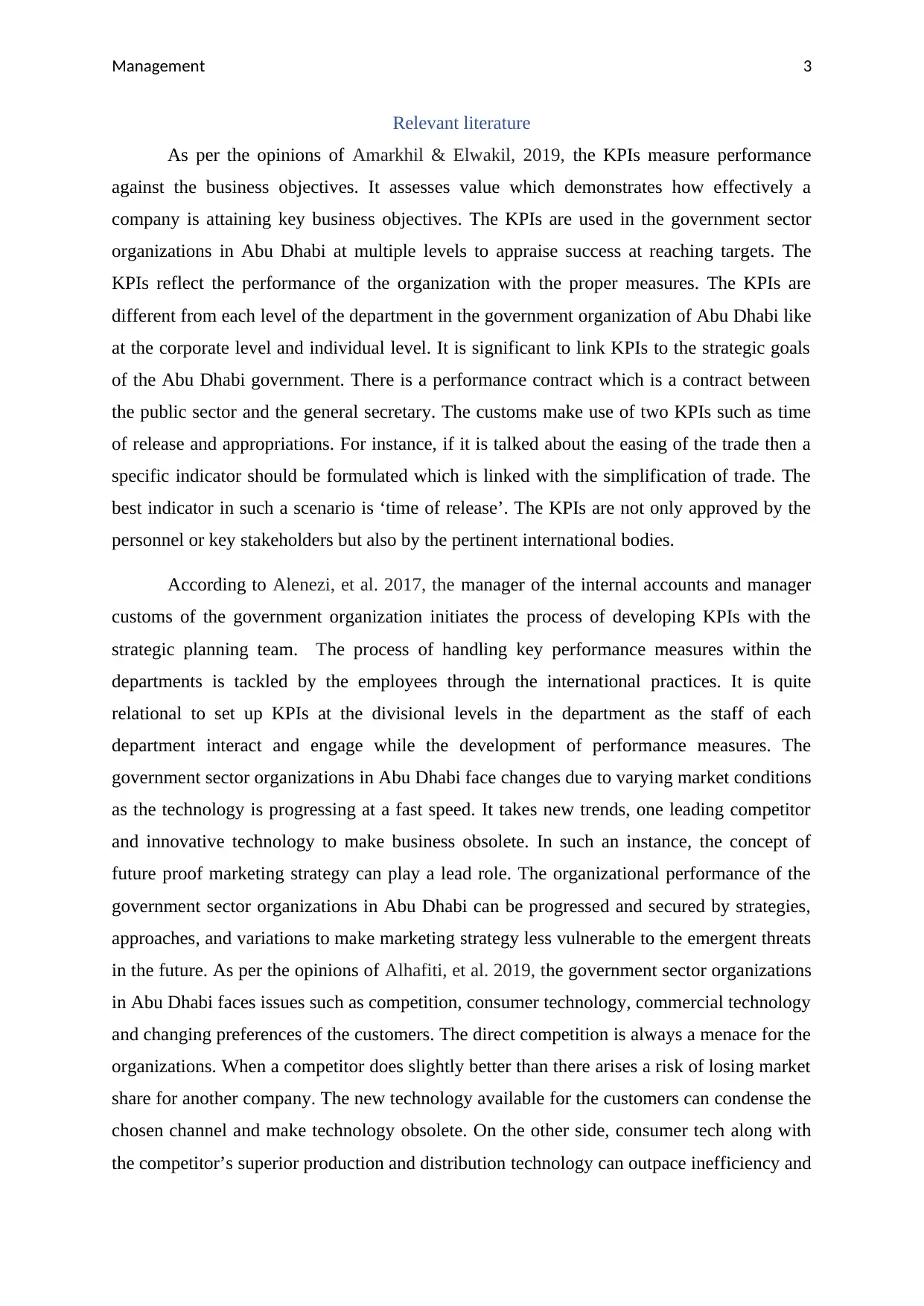
Management 3
Relevant literature
As per the opinions of Amarkhil & Elwakil, 2019, the KPIs measure performance
against the business objectives. It assesses value which demonstrates how effectively a
company is attaining key business objectives. The KPIs are used in the government sector
organizations in Abu Dhabi at multiple levels to appraise success at reaching targets. The
KPIs reflect the performance of the organization with the proper measures. The KPIs are
different from each level of the department in the government organization of Abu Dhabi like
at the corporate level and individual level. It is significant to link KPIs to the strategic goals
of the Abu Dhabi government. There is a performance contract which is a contract between
the public sector and the general secretary. The customs make use of two KPIs such as time
of release and appropriations. For instance, if it is talked about the easing of the trade then a
specific indicator should be formulated which is linked with the simplification of trade. The
best indicator in such a scenario is ‘time of release’. The KPIs are not only approved by the
personnel or key stakeholders but also by the pertinent international bodies.
According to Alenezi, et al. 2017, the manager of the internal accounts and manager
customs of the government organization initiates the process of developing KPIs with the
strategic planning team. The process of handling key performance measures within the
departments is tackled by the employees through the international practices. It is quite
relational to set up KPIs at the divisional levels in the department as the staff of each
department interact and engage while the development of performance measures. The
government sector organizations in Abu Dhabi face changes due to varying market conditions
as the technology is progressing at a fast speed. It takes new trends, one leading competitor
and innovative technology to make business obsolete. In such an instance, the concept of
future proof marketing strategy can play a lead role. The organizational performance of the
government sector organizations in Abu Dhabi can be progressed and secured by strategies,
approaches, and variations to make marketing strategy less vulnerable to the emergent threats
in the future. As per the opinions of Alhafiti, et al. 2019, the government sector organizations
in Abu Dhabi faces issues such as competition, consumer technology, commercial technology
and changing preferences of the customers. The direct competition is always a menace for the
organizations. When a competitor does slightly better than there arises a risk of losing market
share for another company. The new technology available for the customers can condense the
chosen channel and make technology obsolete. On the other side, consumer tech along with
the competitor’s superior production and distribution technology can outpace inefficiency and
Relevant literature
As per the opinions of Amarkhil & Elwakil, 2019, the KPIs measure performance
against the business objectives. It assesses value which demonstrates how effectively a
company is attaining key business objectives. The KPIs are used in the government sector
organizations in Abu Dhabi at multiple levels to appraise success at reaching targets. The
KPIs reflect the performance of the organization with the proper measures. The KPIs are
different from each level of the department in the government organization of Abu Dhabi like
at the corporate level and individual level. It is significant to link KPIs to the strategic goals
of the Abu Dhabi government. There is a performance contract which is a contract between
the public sector and the general secretary. The customs make use of two KPIs such as time
of release and appropriations. For instance, if it is talked about the easing of the trade then a
specific indicator should be formulated which is linked with the simplification of trade. The
best indicator in such a scenario is ‘time of release’. The KPIs are not only approved by the
personnel or key stakeholders but also by the pertinent international bodies.
According to Alenezi, et al. 2017, the manager of the internal accounts and manager
customs of the government organization initiates the process of developing KPIs with the
strategic planning team. The process of handling key performance measures within the
departments is tackled by the employees through the international practices. It is quite
relational to set up KPIs at the divisional levels in the department as the staff of each
department interact and engage while the development of performance measures. The
government sector organizations in Abu Dhabi face changes due to varying market conditions
as the technology is progressing at a fast speed. It takes new trends, one leading competitor
and innovative technology to make business obsolete. In such an instance, the concept of
future proof marketing strategy can play a lead role. The organizational performance of the
government sector organizations in Abu Dhabi can be progressed and secured by strategies,
approaches, and variations to make marketing strategy less vulnerable to the emergent threats
in the future. As per the opinions of Alhafiti, et al. 2019, the government sector organizations
in Abu Dhabi faces issues such as competition, consumer technology, commercial technology
and changing preferences of the customers. The direct competition is always a menace for the
organizations. When a competitor does slightly better than there arises a risk of losing market
share for another company. The new technology available for the customers can condense the
chosen channel and make technology obsolete. On the other side, consumer tech along with
the competitor’s superior production and distribution technology can outpace inefficiency and
Paraphrase This Document
Need a fresh take? Get an instant paraphrase of this document with our AI Paraphraser
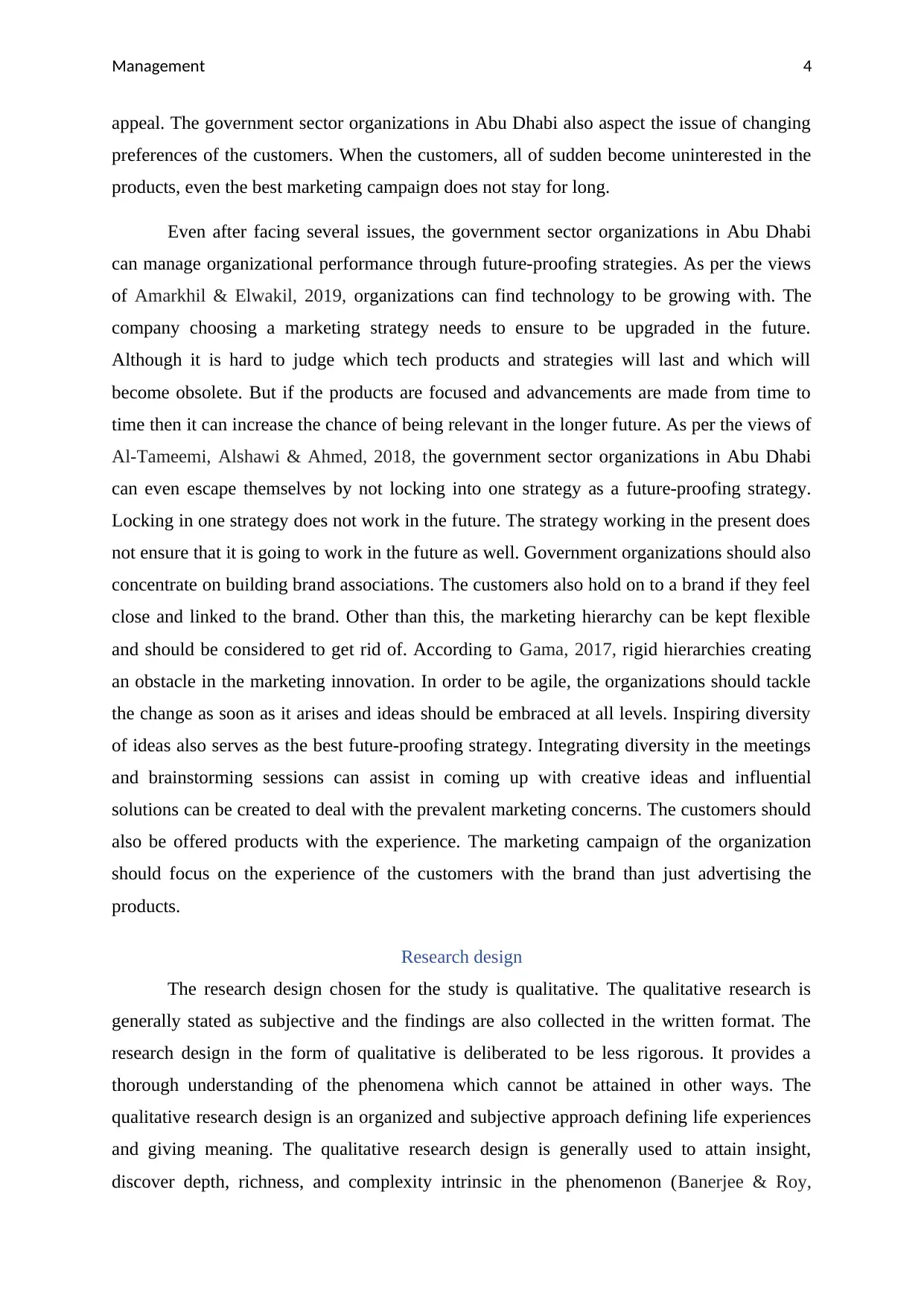
Management 4
appeal. The government sector organizations in Abu Dhabi also aspect the issue of changing
preferences of the customers. When the customers, all of sudden become uninterested in the
products, even the best marketing campaign does not stay for long.
Even after facing several issues, the government sector organizations in Abu Dhabi
can manage organizational performance through future-proofing strategies. As per the views
of Amarkhil & Elwakil, 2019, organizations can find technology to be growing with. The
company choosing a marketing strategy needs to ensure to be upgraded in the future.
Although it is hard to judge which tech products and strategies will last and which will
become obsolete. But if the products are focused and advancements are made from time to
time then it can increase the chance of being relevant in the longer future. As per the views of
Al-Tameemi, Alshawi & Ahmed, 2018, the government sector organizations in Abu Dhabi
can even escape themselves by not locking into one strategy as a future-proofing strategy.
Locking in one strategy does not work in the future. The strategy working in the present does
not ensure that it is going to work in the future as well. Government organizations should also
concentrate on building brand associations. The customers also hold on to a brand if they feel
close and linked to the brand. Other than this, the marketing hierarchy can be kept flexible
and should be considered to get rid of. According to Gama, 2017, rigid hierarchies creating
an obstacle in the marketing innovation. In order to be agile, the organizations should tackle
the change as soon as it arises and ideas should be embraced at all levels. Inspiring diversity
of ideas also serves as the best future-proofing strategy. Integrating diversity in the meetings
and brainstorming sessions can assist in coming up with creative ideas and influential
solutions can be created to deal with the prevalent marketing concerns. The customers should
also be offered products with the experience. The marketing campaign of the organization
should focus on the experience of the customers with the brand than just advertising the
products.
Research design
The research design chosen for the study is qualitative. The qualitative research is
generally stated as subjective and the findings are also collected in the written format. The
research design in the form of qualitative is deliberated to be less rigorous. It provides a
thorough understanding of the phenomena which cannot be attained in other ways. The
qualitative research design is an organized and subjective approach defining life experiences
and giving meaning. The qualitative research design is generally used to attain insight,
discover depth, richness, and complexity intrinsic in the phenomenon (Banerjee & Roy,
appeal. The government sector organizations in Abu Dhabi also aspect the issue of changing
preferences of the customers. When the customers, all of sudden become uninterested in the
products, even the best marketing campaign does not stay for long.
Even after facing several issues, the government sector organizations in Abu Dhabi
can manage organizational performance through future-proofing strategies. As per the views
of Amarkhil & Elwakil, 2019, organizations can find technology to be growing with. The
company choosing a marketing strategy needs to ensure to be upgraded in the future.
Although it is hard to judge which tech products and strategies will last and which will
become obsolete. But if the products are focused and advancements are made from time to
time then it can increase the chance of being relevant in the longer future. As per the views of
Al-Tameemi, Alshawi & Ahmed, 2018, the government sector organizations in Abu Dhabi
can even escape themselves by not locking into one strategy as a future-proofing strategy.
Locking in one strategy does not work in the future. The strategy working in the present does
not ensure that it is going to work in the future as well. Government organizations should also
concentrate on building brand associations. The customers also hold on to a brand if they feel
close and linked to the brand. Other than this, the marketing hierarchy can be kept flexible
and should be considered to get rid of. According to Gama, 2017, rigid hierarchies creating
an obstacle in the marketing innovation. In order to be agile, the organizations should tackle
the change as soon as it arises and ideas should be embraced at all levels. Inspiring diversity
of ideas also serves as the best future-proofing strategy. Integrating diversity in the meetings
and brainstorming sessions can assist in coming up with creative ideas and influential
solutions can be created to deal with the prevalent marketing concerns. The customers should
also be offered products with the experience. The marketing campaign of the organization
should focus on the experience of the customers with the brand than just advertising the
products.
Research design
The research design chosen for the study is qualitative. The qualitative research is
generally stated as subjective and the findings are also collected in the written format. The
research design in the form of qualitative is deliberated to be less rigorous. It provides a
thorough understanding of the phenomena which cannot be attained in other ways. The
qualitative research design is an organized and subjective approach defining life experiences
and giving meaning. The qualitative research design is generally used to attain insight,
discover depth, richness, and complexity intrinsic in the phenomenon (Banerjee & Roy,
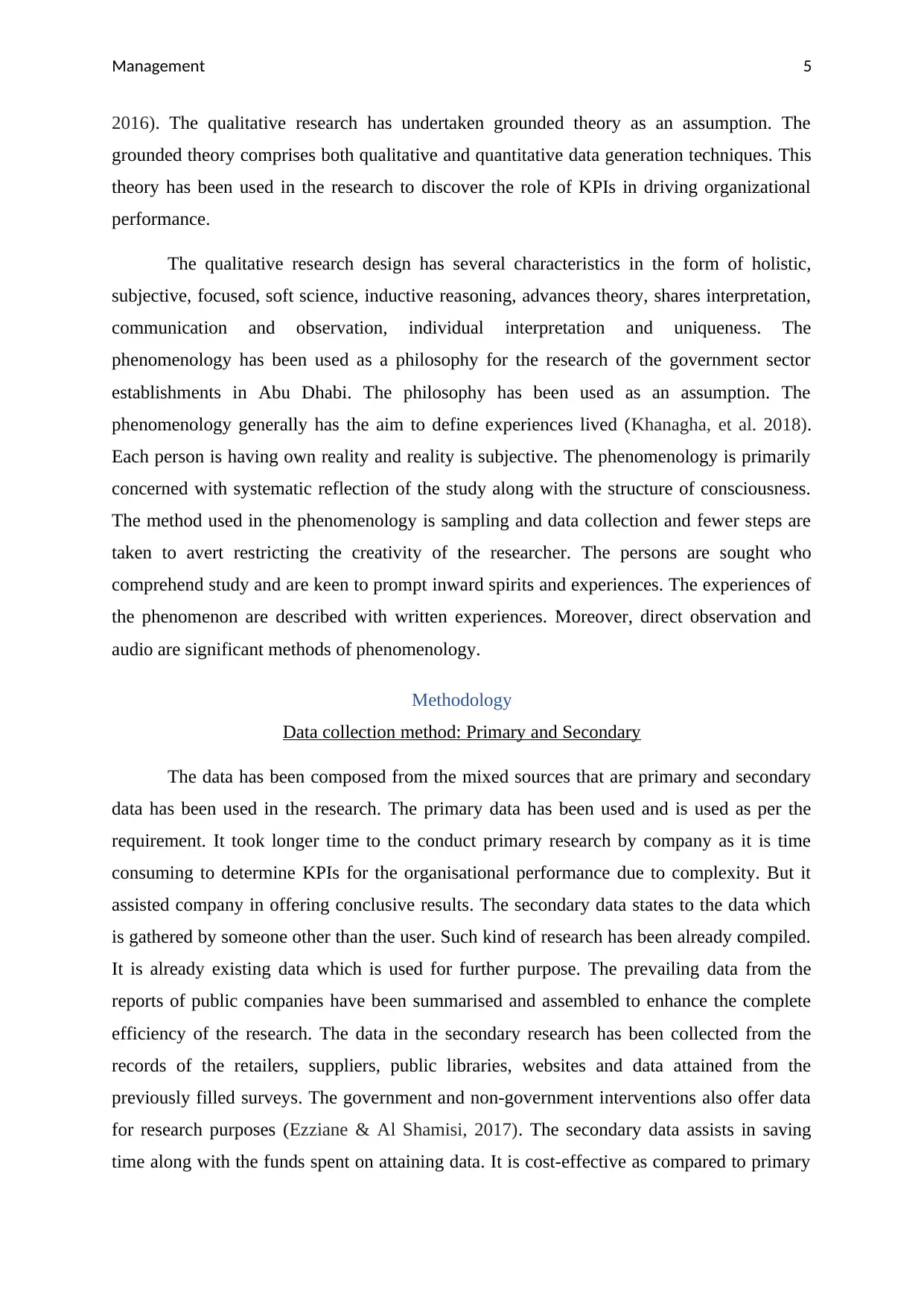
Management 5
2016). The qualitative research has undertaken grounded theory as an assumption. The
grounded theory comprises both qualitative and quantitative data generation techniques. This
theory has been used in the research to discover the role of KPIs in driving organizational
performance.
The qualitative research design has several characteristics in the form of holistic,
subjective, focused, soft science, inductive reasoning, advances theory, shares interpretation,
communication and observation, individual interpretation and uniqueness. The
phenomenology has been used as a philosophy for the research of the government sector
establishments in Abu Dhabi. The philosophy has been used as an assumption. The
phenomenology generally has the aim to define experiences lived (Khanagha, et al. 2018).
Each person is having own reality and reality is subjective. The phenomenology is primarily
concerned with systematic reflection of the study along with the structure of consciousness.
The method used in the phenomenology is sampling and data collection and fewer steps are
taken to avert restricting the creativity of the researcher. The persons are sought who
comprehend study and are keen to prompt inward spirits and experiences. The experiences of
the phenomenon are described with written experiences. Moreover, direct observation and
audio are significant methods of phenomenology.
Methodology
Data collection method: Primary and Secondary
The data has been composed from the mixed sources that are primary and secondary
data has been used in the research. The primary data has been used and is used as per the
requirement. It took longer time to the conduct primary research by company as it is time
consuming to determine KPIs for the organisational performance due to complexity. But it
assisted company in offering conclusive results. The secondary data states to the data which
is gathered by someone other than the user. Such kind of research has been already compiled.
It is already existing data which is used for further purpose. The prevailing data from the
reports of public companies have been summarised and assembled to enhance the complete
efficiency of the research. The data in the secondary research has been collected from the
records of the retailers, suppliers, public libraries, websites and data attained from the
previously filled surveys. The government and non-government interventions also offer data
for research purposes (Ezziane & Al Shamisi, 2017). The secondary data assists in saving
time along with the funds spent on attaining data. It is cost-effective as compared to primary
2016). The qualitative research has undertaken grounded theory as an assumption. The
grounded theory comprises both qualitative and quantitative data generation techniques. This
theory has been used in the research to discover the role of KPIs in driving organizational
performance.
The qualitative research design has several characteristics in the form of holistic,
subjective, focused, soft science, inductive reasoning, advances theory, shares interpretation,
communication and observation, individual interpretation and uniqueness. The
phenomenology has been used as a philosophy for the research of the government sector
establishments in Abu Dhabi. The philosophy has been used as an assumption. The
phenomenology generally has the aim to define experiences lived (Khanagha, et al. 2018).
Each person is having own reality and reality is subjective. The phenomenology is primarily
concerned with systematic reflection of the study along with the structure of consciousness.
The method used in the phenomenology is sampling and data collection and fewer steps are
taken to avert restricting the creativity of the researcher. The persons are sought who
comprehend study and are keen to prompt inward spirits and experiences. The experiences of
the phenomenon are described with written experiences. Moreover, direct observation and
audio are significant methods of phenomenology.
Methodology
Data collection method: Primary and Secondary
The data has been composed from the mixed sources that are primary and secondary
data has been used in the research. The primary data has been used and is used as per the
requirement. It took longer time to the conduct primary research by company as it is time
consuming to determine KPIs for the organisational performance due to complexity. But it
assisted company in offering conclusive results. The secondary data states to the data which
is gathered by someone other than the user. Such kind of research has been already compiled.
It is already existing data which is used for further purpose. The prevailing data from the
reports of public companies have been summarised and assembled to enhance the complete
efficiency of the research. The data in the secondary research has been collected from the
records of the retailers, suppliers, public libraries, websites and data attained from the
previously filled surveys. The government and non-government interventions also offer data
for research purposes (Ezziane & Al Shamisi, 2017). The secondary data assists in saving
time along with the funds spent on attaining data. It is cost-effective as compared to primary
⊘ This is a preview!⊘
Do you want full access?
Subscribe today to unlock all pages.

Trusted by 1+ million students worldwide
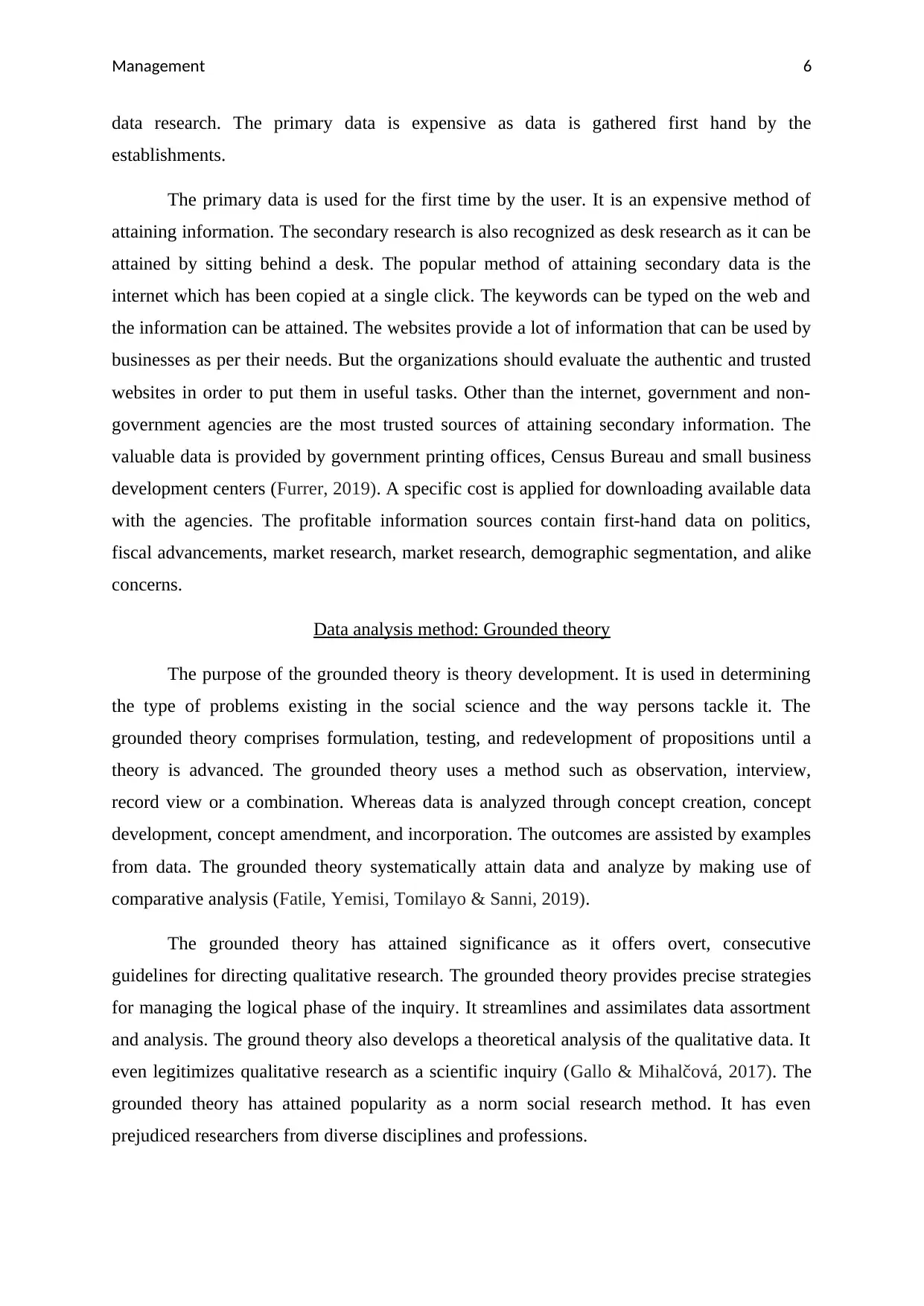
Management 6
data research. The primary data is expensive as data is gathered first hand by the
establishments.
The primary data is used for the first time by the user. It is an expensive method of
attaining information. The secondary research is also recognized as desk research as it can be
attained by sitting behind a desk. The popular method of attaining secondary data is the
internet which has been copied at a single click. The keywords can be typed on the web and
the information can be attained. The websites provide a lot of information that can be used by
businesses as per their needs. But the organizations should evaluate the authentic and trusted
websites in order to put them in useful tasks. Other than the internet, government and non-
government agencies are the most trusted sources of attaining secondary information. The
valuable data is provided by government printing offices, Census Bureau and small business
development centers (Furrer, 2019). A specific cost is applied for downloading available data
with the agencies. The profitable information sources contain first-hand data on politics,
fiscal advancements, market research, market research, demographic segmentation, and alike
concerns.
Data analysis method: Grounded theory
The purpose of the grounded theory is theory development. It is used in determining
the type of problems existing in the social science and the way persons tackle it. The
grounded theory comprises formulation, testing, and redevelopment of propositions until a
theory is advanced. The grounded theory uses a method such as observation, interview,
record view or a combination. Whereas data is analyzed through concept creation, concept
development, concept amendment, and incorporation. The outcomes are assisted by examples
from data. The grounded theory systematically attain data and analyze by making use of
comparative analysis (Fatile, Yemisi, Tomilayo & Sanni, 2019).
The grounded theory has attained significance as it offers overt, consecutive
guidelines for directing qualitative research. The grounded theory provides precise strategies
for managing the logical phase of the inquiry. It streamlines and assimilates data assortment
and analysis. The ground theory also develops a theoretical analysis of the qualitative data. It
even legitimizes qualitative research as a scientific inquiry (Gallo & Mihalčová, 2017). The
grounded theory has attained popularity as a norm social research method. It has even
prejudiced researchers from diverse disciplines and professions.
data research. The primary data is expensive as data is gathered first hand by the
establishments.
The primary data is used for the first time by the user. It is an expensive method of
attaining information. The secondary research is also recognized as desk research as it can be
attained by sitting behind a desk. The popular method of attaining secondary data is the
internet which has been copied at a single click. The keywords can be typed on the web and
the information can be attained. The websites provide a lot of information that can be used by
businesses as per their needs. But the organizations should evaluate the authentic and trusted
websites in order to put them in useful tasks. Other than the internet, government and non-
government agencies are the most trusted sources of attaining secondary information. The
valuable data is provided by government printing offices, Census Bureau and small business
development centers (Furrer, 2019). A specific cost is applied for downloading available data
with the agencies. The profitable information sources contain first-hand data on politics,
fiscal advancements, market research, market research, demographic segmentation, and alike
concerns.
Data analysis method: Grounded theory
The purpose of the grounded theory is theory development. It is used in determining
the type of problems existing in the social science and the way persons tackle it. The
grounded theory comprises formulation, testing, and redevelopment of propositions until a
theory is advanced. The grounded theory uses a method such as observation, interview,
record view or a combination. Whereas data is analyzed through concept creation, concept
development, concept amendment, and incorporation. The outcomes are assisted by examples
from data. The grounded theory systematically attain data and analyze by making use of
comparative analysis (Fatile, Yemisi, Tomilayo & Sanni, 2019).
The grounded theory has attained significance as it offers overt, consecutive
guidelines for directing qualitative research. The grounded theory provides precise strategies
for managing the logical phase of the inquiry. It streamlines and assimilates data assortment
and analysis. The ground theory also develops a theoretical analysis of the qualitative data. It
even legitimizes qualitative research as a scientific inquiry (Gallo & Mihalčová, 2017). The
grounded theory has attained popularity as a norm social research method. It has even
prejudiced researchers from diverse disciplines and professions.
Paraphrase This Document
Need a fresh take? Get an instant paraphrase of this document with our AI Paraphraser
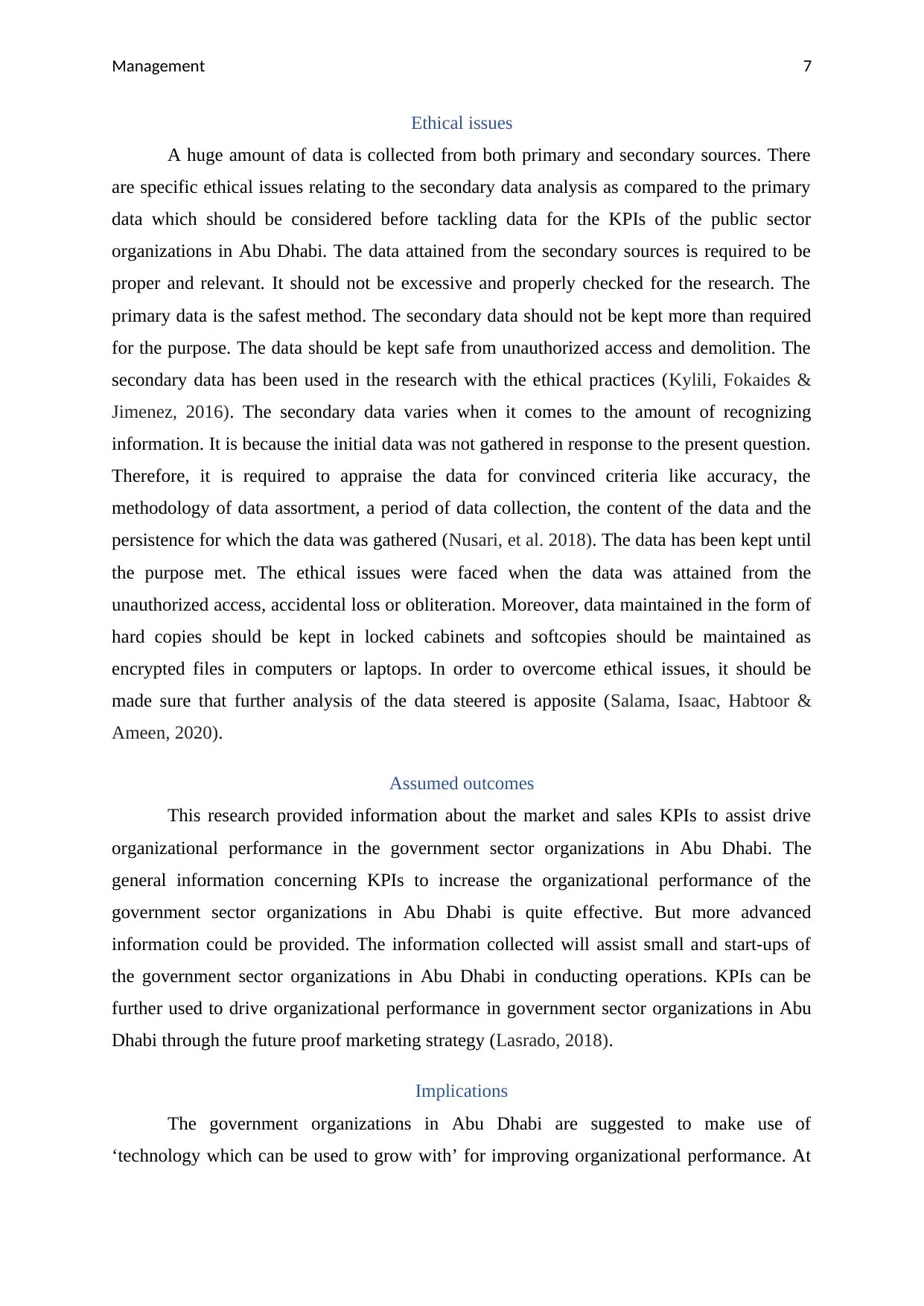
Management 7
Ethical issues
A huge amount of data is collected from both primary and secondary sources. There
are specific ethical issues relating to the secondary data analysis as compared to the primary
data which should be considered before tackling data for the KPIs of the public sector
organizations in Abu Dhabi. The data attained from the secondary sources is required to be
proper and relevant. It should not be excessive and properly checked for the research. The
primary data is the safest method. The secondary data should not be kept more than required
for the purpose. The data should be kept safe from unauthorized access and demolition. The
secondary data has been used in the research with the ethical practices (Kylili, Fokaides &
Jimenez, 2016). The secondary data varies when it comes to the amount of recognizing
information. It is because the initial data was not gathered in response to the present question.
Therefore, it is required to appraise the data for convinced criteria like accuracy, the
methodology of data assortment, a period of data collection, the content of the data and the
persistence for which the data was gathered (Nusari, et al. 2018). The data has been kept until
the purpose met. The ethical issues were faced when the data was attained from the
unauthorized access, accidental loss or obliteration. Moreover, data maintained in the form of
hard copies should be kept in locked cabinets and softcopies should be maintained as
encrypted files in computers or laptops. In order to overcome ethical issues, it should be
made sure that further analysis of the data steered is apposite (Salama, Isaac, Habtoor &
Ameen, 2020).
Assumed outcomes
This research provided information about the market and sales KPIs to assist drive
organizational performance in the government sector organizations in Abu Dhabi. The
general information concerning KPIs to increase the organizational performance of the
government sector organizations in Abu Dhabi is quite effective. But more advanced
information could be provided. The information collected will assist small and start-ups of
the government sector organizations in Abu Dhabi in conducting operations. KPIs can be
further used to drive organizational performance in government sector organizations in Abu
Dhabi through the future proof marketing strategy (Lasrado, 2018).
Implications
The government organizations in Abu Dhabi are suggested to make use of
‘technology which can be used to grow with’ for improving organizational performance. At
Ethical issues
A huge amount of data is collected from both primary and secondary sources. There
are specific ethical issues relating to the secondary data analysis as compared to the primary
data which should be considered before tackling data for the KPIs of the public sector
organizations in Abu Dhabi. The data attained from the secondary sources is required to be
proper and relevant. It should not be excessive and properly checked for the research. The
primary data is the safest method. The secondary data should not be kept more than required
for the purpose. The data should be kept safe from unauthorized access and demolition. The
secondary data has been used in the research with the ethical practices (Kylili, Fokaides &
Jimenez, 2016). The secondary data varies when it comes to the amount of recognizing
information. It is because the initial data was not gathered in response to the present question.
Therefore, it is required to appraise the data for convinced criteria like accuracy, the
methodology of data assortment, a period of data collection, the content of the data and the
persistence for which the data was gathered (Nusari, et al. 2018). The data has been kept until
the purpose met. The ethical issues were faced when the data was attained from the
unauthorized access, accidental loss or obliteration. Moreover, data maintained in the form of
hard copies should be kept in locked cabinets and softcopies should be maintained as
encrypted files in computers or laptops. In order to overcome ethical issues, it should be
made sure that further analysis of the data steered is apposite (Salama, Isaac, Habtoor &
Ameen, 2020).
Assumed outcomes
This research provided information about the market and sales KPIs to assist drive
organizational performance in the government sector organizations in Abu Dhabi. The
general information concerning KPIs to increase the organizational performance of the
government sector organizations in Abu Dhabi is quite effective. But more advanced
information could be provided. The information collected will assist small and start-ups of
the government sector organizations in Abu Dhabi in conducting operations. KPIs can be
further used to drive organizational performance in government sector organizations in Abu
Dhabi through the future proof marketing strategy (Lasrado, 2018).
Implications
The government organizations in Abu Dhabi are suggested to make use of
‘technology which can be used to grow with’ for improving organizational performance. At
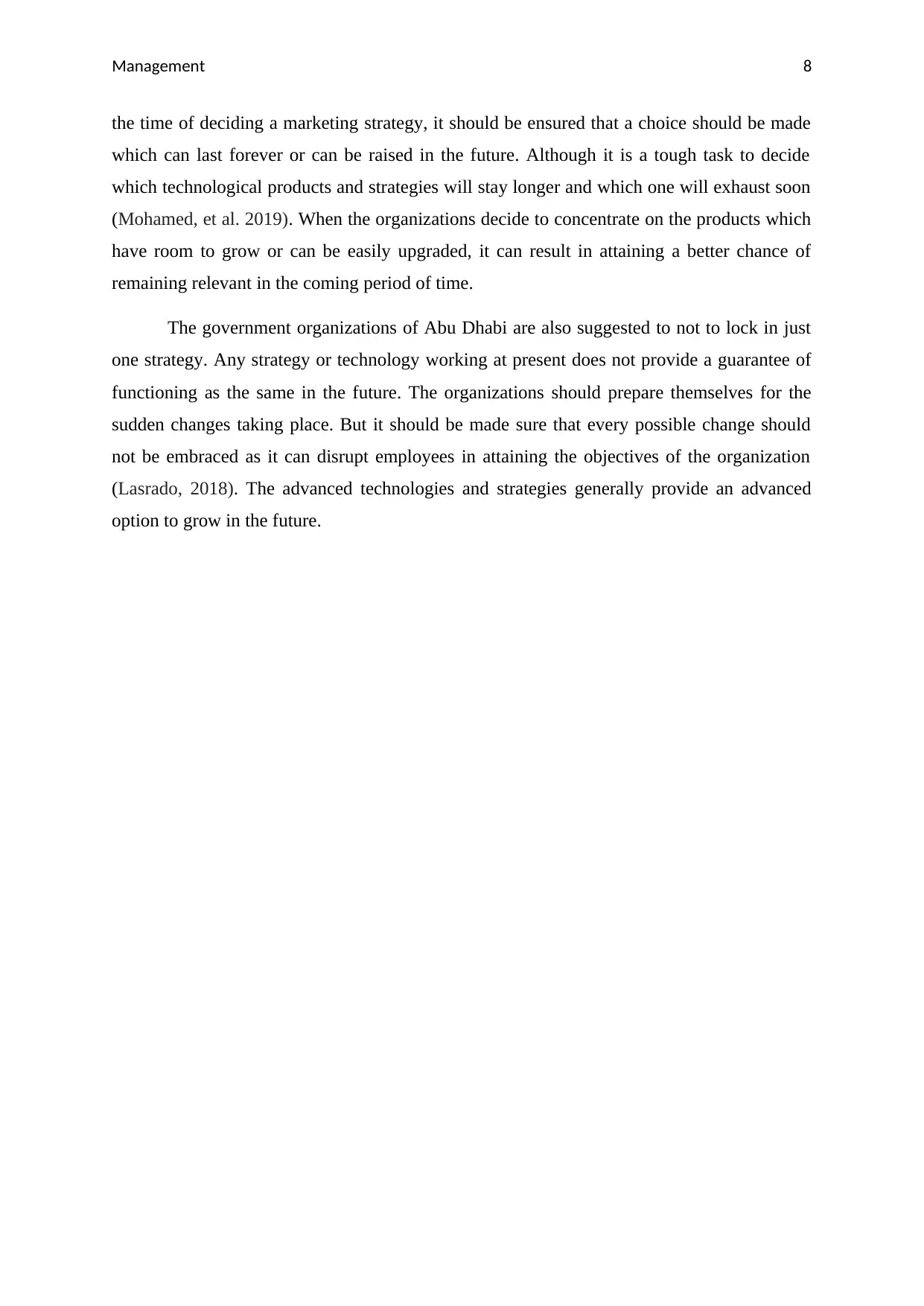
Management 8
the time of deciding a marketing strategy, it should be ensured that a choice should be made
which can last forever or can be raised in the future. Although it is a tough task to decide
which technological products and strategies will stay longer and which one will exhaust soon
(Mohamed, et al. 2019). When the organizations decide to concentrate on the products which
have room to grow or can be easily upgraded, it can result in attaining a better chance of
remaining relevant in the coming period of time.
The government organizations of Abu Dhabi are also suggested to not to lock in just
one strategy. Any strategy or technology working at present does not provide a guarantee of
functioning as the same in the future. The organizations should prepare themselves for the
sudden changes taking place. But it should be made sure that every possible change should
not be embraced as it can disrupt employees in attaining the objectives of the organization
(Lasrado, 2018). The advanced technologies and strategies generally provide an advanced
option to grow in the future.
the time of deciding a marketing strategy, it should be ensured that a choice should be made
which can last forever or can be raised in the future. Although it is a tough task to decide
which technological products and strategies will stay longer and which one will exhaust soon
(Mohamed, et al. 2019). When the organizations decide to concentrate on the products which
have room to grow or can be easily upgraded, it can result in attaining a better chance of
remaining relevant in the coming period of time.
The government organizations of Abu Dhabi are also suggested to not to lock in just
one strategy. Any strategy or technology working at present does not provide a guarantee of
functioning as the same in the future. The organizations should prepare themselves for the
sudden changes taking place. But it should be made sure that every possible change should
not be embraced as it can disrupt employees in attaining the objectives of the organization
(Lasrado, 2018). The advanced technologies and strategies generally provide an advanced
option to grow in the future.
⊘ This is a preview!⊘
Do you want full access?
Subscribe today to unlock all pages.

Trusted by 1+ million students worldwide
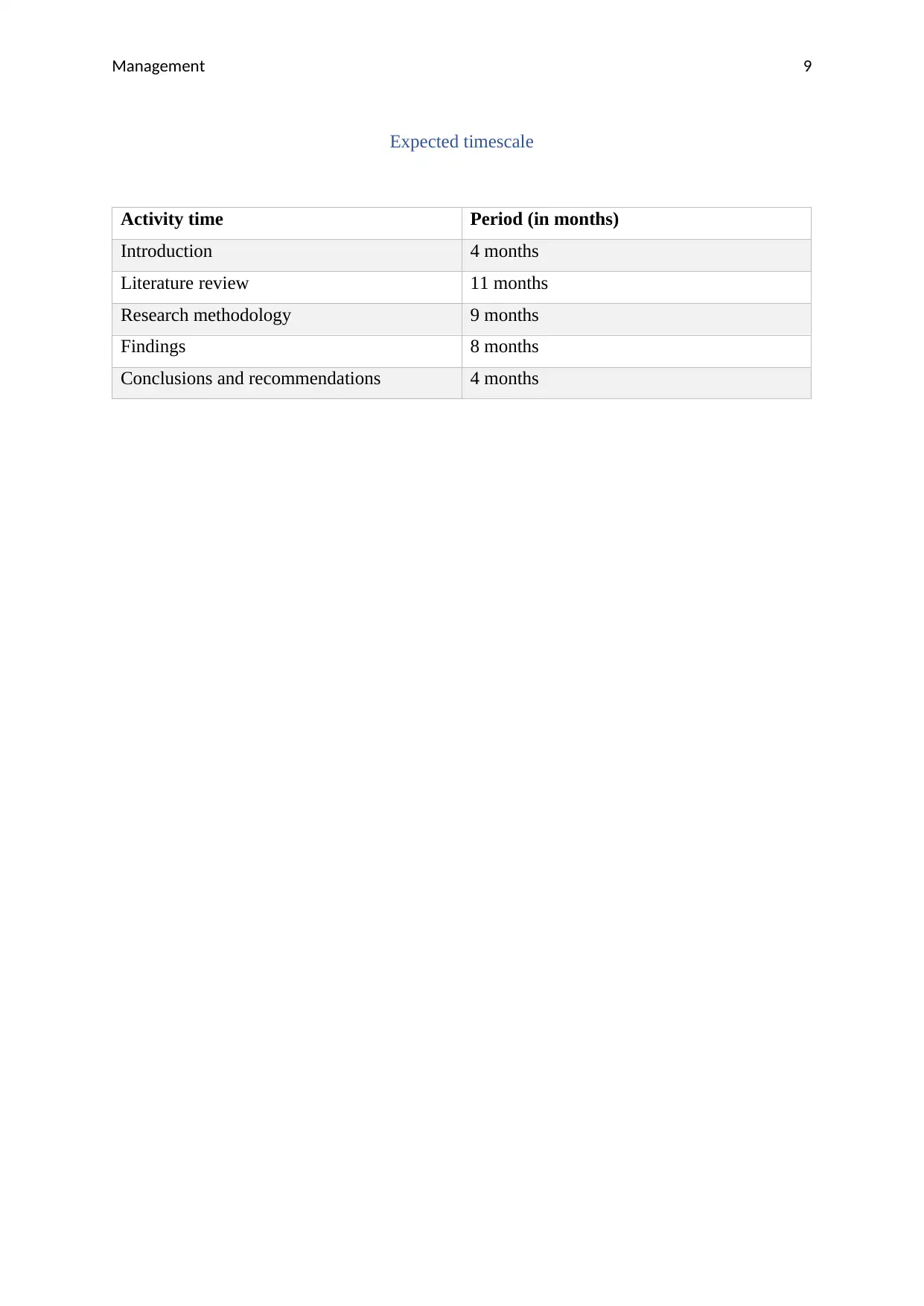
Management 9
Expected timescale
Activity time Period (in months)
Introduction 4 months
Literature review 11 months
Research methodology 9 months
Findings 8 months
Conclusions and recommendations 4 months
Expected timescale
Activity time Period (in months)
Introduction 4 months
Literature review 11 months
Research methodology 9 months
Findings 8 months
Conclusions and recommendations 4 months
Paraphrase This Document
Need a fresh take? Get an instant paraphrase of this document with our AI Paraphraser
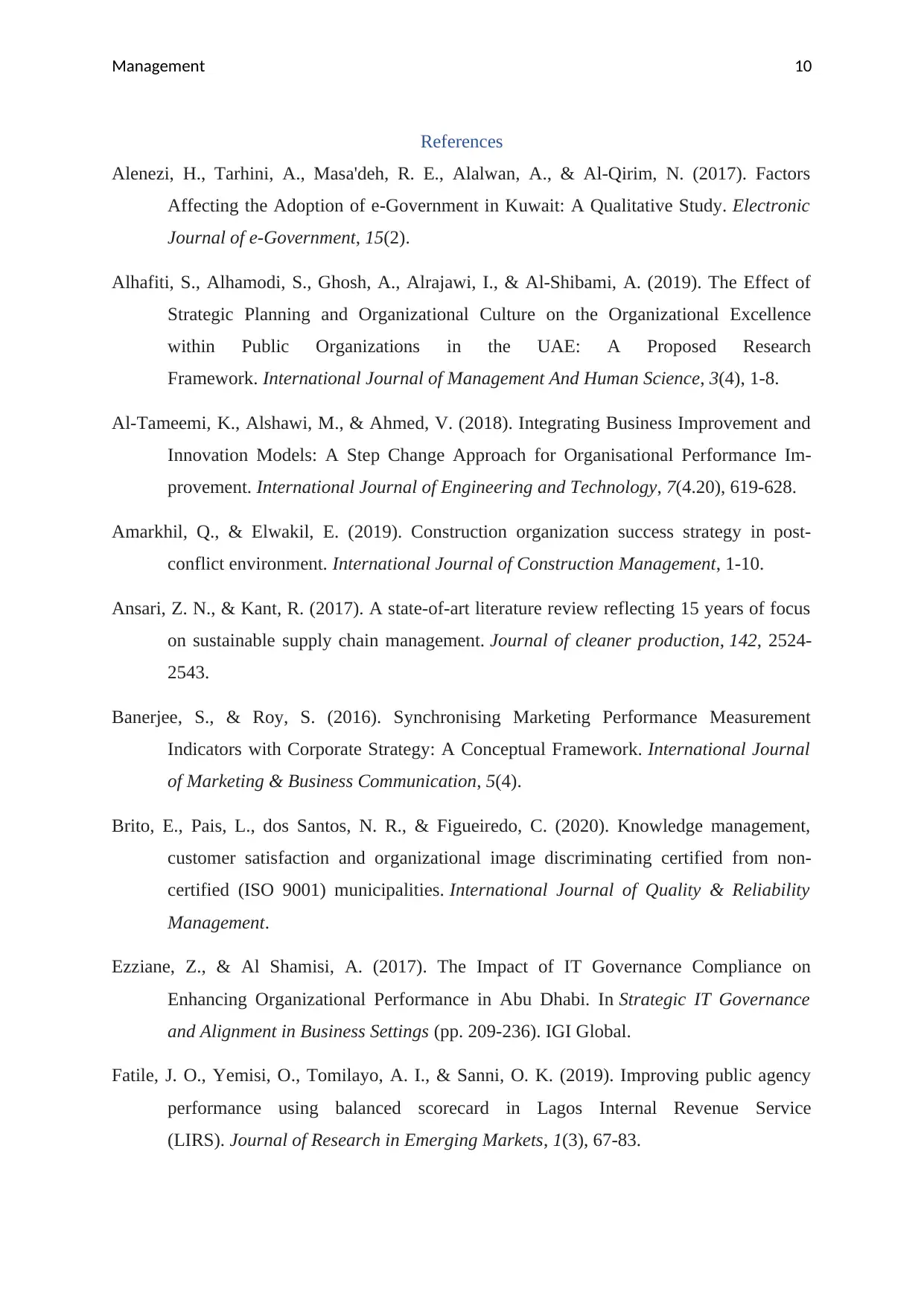
Management 10
References
Alenezi, H., Tarhini, A., Masa'deh, R. E., Alalwan, A., & Al-Qirim, N. (2017). Factors
Affecting the Adoption of e-Government in Kuwait: A Qualitative Study. Electronic
Journal of e-Government, 15(2).
Alhafiti, S., Alhamodi, S., Ghosh, A., Alrajawi, I., & Al-Shibami, A. (2019). The Effect of
Strategic Planning and Organizational Culture on the Organizational Excellence
within Public Organizations in the UAE: A Proposed Research
Framework. International Journal of Management And Human Science, 3(4), 1-8.
Al-Tameemi, K., Alshawi, M., & Ahmed, V. (2018). Integrating Business Improvement and
Innovation Models: A Step Change Approach for Organisational Performance Im-
provement. International Journal of Engineering and Technology, 7(4.20), 619-628.
Amarkhil, Q., & Elwakil, E. (2019). Construction organization success strategy in post-
conflict environment. International Journal of Construction Management, 1-10.
Ansari, Z. N., & Kant, R. (2017). A state-of-art literature review reflecting 15 years of focus
on sustainable supply chain management. Journal of cleaner production, 142, 2524-
2543.
Banerjee, S., & Roy, S. (2016). Synchronising Marketing Performance Measurement
Indicators with Corporate Strategy: A Conceptual Framework. International Journal
of Marketing & Business Communication, 5(4).
Brito, E., Pais, L., dos Santos, N. R., & Figueiredo, C. (2020). Knowledge management,
customer satisfaction and organizational image discriminating certified from non-
certified (ISO 9001) municipalities. International Journal of Quality & Reliability
Management.
Ezziane, Z., & Al Shamisi, A. (2017). The Impact of IT Governance Compliance on
Enhancing Organizational Performance in Abu Dhabi. In Strategic IT Governance
and Alignment in Business Settings (pp. 209-236). IGI Global.
Fatile, J. O., Yemisi, O., Tomilayo, A. I., & Sanni, O. K. (2019). Improving public agency
performance using balanced scorecard in Lagos Internal Revenue Service
(LIRS). Journal of Research in Emerging Markets, 1(3), 67-83.
References
Alenezi, H., Tarhini, A., Masa'deh, R. E., Alalwan, A., & Al-Qirim, N. (2017). Factors
Affecting the Adoption of e-Government in Kuwait: A Qualitative Study. Electronic
Journal of e-Government, 15(2).
Alhafiti, S., Alhamodi, S., Ghosh, A., Alrajawi, I., & Al-Shibami, A. (2019). The Effect of
Strategic Planning and Organizational Culture on the Organizational Excellence
within Public Organizations in the UAE: A Proposed Research
Framework. International Journal of Management And Human Science, 3(4), 1-8.
Al-Tameemi, K., Alshawi, M., & Ahmed, V. (2018). Integrating Business Improvement and
Innovation Models: A Step Change Approach for Organisational Performance Im-
provement. International Journal of Engineering and Technology, 7(4.20), 619-628.
Amarkhil, Q., & Elwakil, E. (2019). Construction organization success strategy in post-
conflict environment. International Journal of Construction Management, 1-10.
Ansari, Z. N., & Kant, R. (2017). A state-of-art literature review reflecting 15 years of focus
on sustainable supply chain management. Journal of cleaner production, 142, 2524-
2543.
Banerjee, S., & Roy, S. (2016). Synchronising Marketing Performance Measurement
Indicators with Corporate Strategy: A Conceptual Framework. International Journal
of Marketing & Business Communication, 5(4).
Brito, E., Pais, L., dos Santos, N. R., & Figueiredo, C. (2020). Knowledge management,
customer satisfaction and organizational image discriminating certified from non-
certified (ISO 9001) municipalities. International Journal of Quality & Reliability
Management.
Ezziane, Z., & Al Shamisi, A. (2017). The Impact of IT Governance Compliance on
Enhancing Organizational Performance in Abu Dhabi. In Strategic IT Governance
and Alignment in Business Settings (pp. 209-236). IGI Global.
Fatile, J. O., Yemisi, O., Tomilayo, A. I., & Sanni, O. K. (2019). Improving public agency
performance using balanced scorecard in Lagos Internal Revenue Service
(LIRS). Journal of Research in Emerging Markets, 1(3), 67-83.
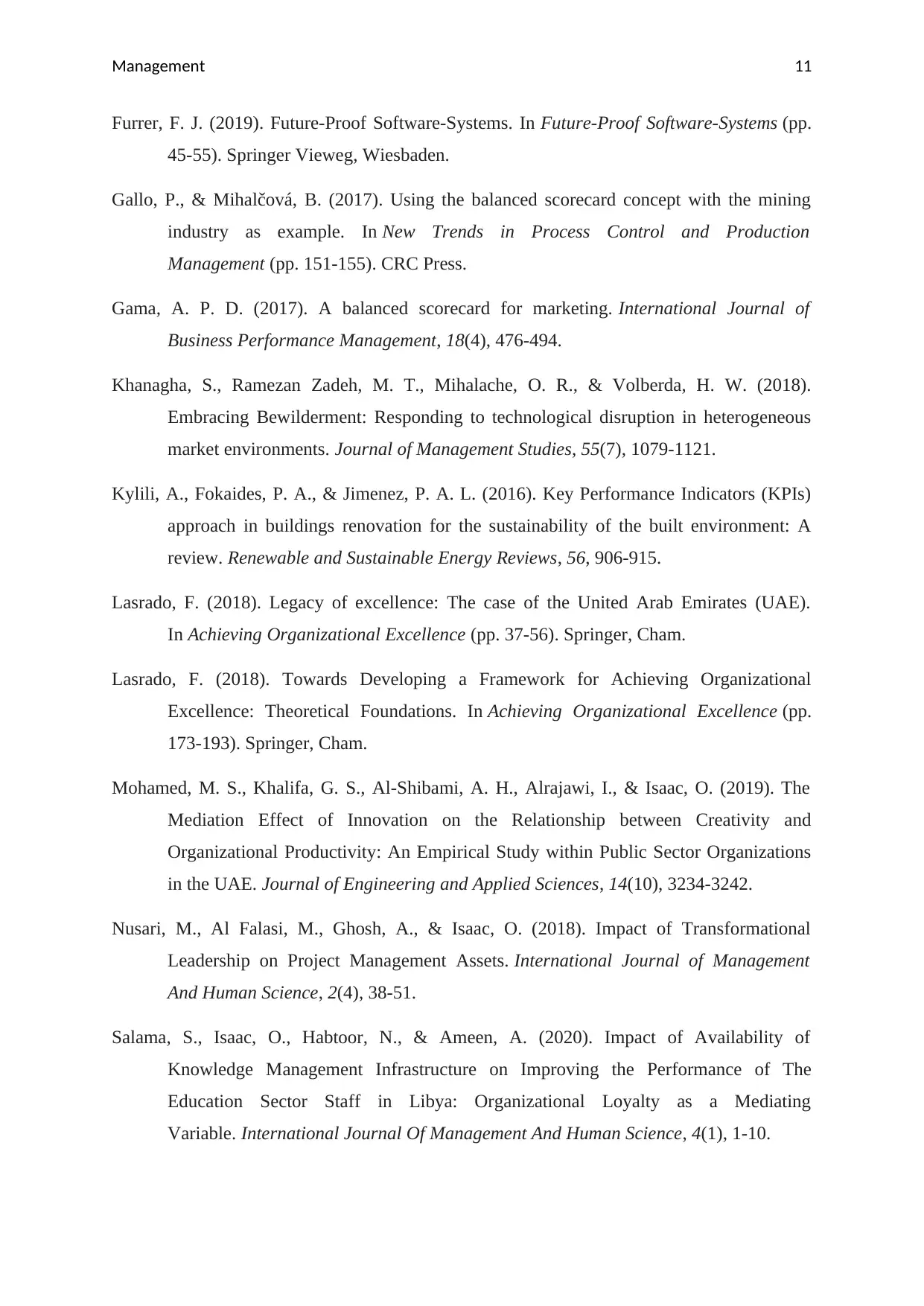
Management 11
Furrer, F. J. (2019). Future-Proof Software-Systems. In Future-Proof Software-Systems (pp.
45-55). Springer Vieweg, Wiesbaden.
Gallo, P., & Mihalčová, B. (2017). Using the balanced scorecard concept with the mining
industry as example. In New Trends in Process Control and Production
Management (pp. 151-155). CRC Press.
Gama, A. P. D. (2017). A balanced scorecard for marketing. International Journal of
Business Performance Management, 18(4), 476-494.
Khanagha, S., Ramezan Zadeh, M. T., Mihalache, O. R., & Volberda, H. W. (2018).
Embracing Bewilderment: Responding to technological disruption in heterogeneous
market environments. Journal of Management Studies, 55(7), 1079-1121.
Kylili, A., Fokaides, P. A., & Jimenez, P. A. L. (2016). Key Performance Indicators (KPIs)
approach in buildings renovation for the sustainability of the built environment: A
review. Renewable and Sustainable Energy Reviews, 56, 906-915.
Lasrado, F. (2018). Legacy of excellence: The case of the United Arab Emirates (UAE).
In Achieving Organizational Excellence (pp. 37-56). Springer, Cham.
Lasrado, F. (2018). Towards Developing a Framework for Achieving Organizational
Excellence: Theoretical Foundations. In Achieving Organizational Excellence (pp.
173-193). Springer, Cham.
Mohamed, M. S., Khalifa, G. S., Al-Shibami, A. H., Alrajawi, I., & Isaac, O. (2019). The
Mediation Effect of Innovation on the Relationship between Creativity and
Organizational Productivity: An Empirical Study within Public Sector Organizations
in the UAE. Journal of Engineering and Applied Sciences, 14(10), 3234-3242.
Nusari, M., Al Falasi, M., Ghosh, A., & Isaac, O. (2018). Impact of Transformational
Leadership on Project Management Assets. International Journal of Management
And Human Science, 2(4), 38-51.
Salama, S., Isaac, O., Habtoor, N., & Ameen, A. (2020). Impact of Availability of
Knowledge Management Infrastructure on Improving the Performance of The
Education Sector Staff in Libya: Organizational Loyalty as a Mediating
Variable. International Journal Of Management And Human Science, 4(1), 1-10.
Furrer, F. J. (2019). Future-Proof Software-Systems. In Future-Proof Software-Systems (pp.
45-55). Springer Vieweg, Wiesbaden.
Gallo, P., & Mihalčová, B. (2017). Using the balanced scorecard concept with the mining
industry as example. In New Trends in Process Control and Production
Management (pp. 151-155). CRC Press.
Gama, A. P. D. (2017). A balanced scorecard for marketing. International Journal of
Business Performance Management, 18(4), 476-494.
Khanagha, S., Ramezan Zadeh, M. T., Mihalache, O. R., & Volberda, H. W. (2018).
Embracing Bewilderment: Responding to technological disruption in heterogeneous
market environments. Journal of Management Studies, 55(7), 1079-1121.
Kylili, A., Fokaides, P. A., & Jimenez, P. A. L. (2016). Key Performance Indicators (KPIs)
approach in buildings renovation for the sustainability of the built environment: A
review. Renewable and Sustainable Energy Reviews, 56, 906-915.
Lasrado, F. (2018). Legacy of excellence: The case of the United Arab Emirates (UAE).
In Achieving Organizational Excellence (pp. 37-56). Springer, Cham.
Lasrado, F. (2018). Towards Developing a Framework for Achieving Organizational
Excellence: Theoretical Foundations. In Achieving Organizational Excellence (pp.
173-193). Springer, Cham.
Mohamed, M. S., Khalifa, G. S., Al-Shibami, A. H., Alrajawi, I., & Isaac, O. (2019). The
Mediation Effect of Innovation on the Relationship between Creativity and
Organizational Productivity: An Empirical Study within Public Sector Organizations
in the UAE. Journal of Engineering and Applied Sciences, 14(10), 3234-3242.
Nusari, M., Al Falasi, M., Ghosh, A., & Isaac, O. (2018). Impact of Transformational
Leadership on Project Management Assets. International Journal of Management
And Human Science, 2(4), 38-51.
Salama, S., Isaac, O., Habtoor, N., & Ameen, A. (2020). Impact of Availability of
Knowledge Management Infrastructure on Improving the Performance of The
Education Sector Staff in Libya: Organizational Loyalty as a Mediating
Variable. International Journal Of Management And Human Science, 4(1), 1-10.
⊘ This is a preview!⊘
Do you want full access?
Subscribe today to unlock all pages.

Trusted by 1+ million students worldwide
1 out of 12
Related Documents
Your All-in-One AI-Powered Toolkit for Academic Success.
+13062052269
info@desklib.com
Available 24*7 on WhatsApp / Email
![[object Object]](/_next/static/media/star-bottom.7253800d.svg)
Unlock your academic potential
Copyright © 2020–2025 A2Z Services. All Rights Reserved. Developed and managed by ZUCOL.





